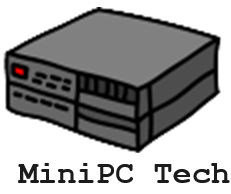Today, I’m going to be talking about the surge in popularity of Mini PCs. These compact powerhouses are becoming a go-to for both home and office setups, offering customization and performance in a pint-sized package. This isn’t just about saving space; it’s about maximizing efficiency with a personalized touch. For do-it-yourselfers, people who want a better cooling environment or make a statement, you need to look at the mini pc case.
Note: there are affiliate links in this post. As an Amazon Associate, I might make a commission from sales, but there is no extra cost to you.
Key Takeaways
- Customization and Efficiency: Mini PC cases offer a blend of personalization and performance, catering to DIY enthusiasts and those seeking optimal cooling and design statements.
- Critical Size Considerations: The dimensions of a Mini PC case are crucial, affecting component compatibility, airflow, and future upgrade possibilities. Always measure your space and plan for growth.
- Features Beyond Aesthetics: Look for cases with easy access to components, ample expansion options, and effective cable management to enhance your Mini PC experience.
- Cooling is Key: Choose a case with the right cooling system, considering both passive and active options, to ensure your Mini PC runs efficiently without overheating.
The Challenge of Choosing the Right Case
You’re going to find out that choosing the right custom case for your Mini PC isn’t as straightforward as picking a cereal off the shelf. There’s a balance to strike – you want something that looks good but also serves every functional need your computing lifestyle demands.
Key Considerations for Selecting a Mini PC Case
So, what should you consider when hunting for the perfect Mini PC case? That’s going to include things like form factor, features, cooling systems, and yes, even aesthetics. I’m here to help you navigate these choices so that your Mini PC not only fits into your space but also exemplifies your preferences and needs.
This guide is tailored to put you – the user – first, armed with practical tips and insights. I’ve made it my mission to ensure you’re equipped with the necessary information to make an informed decision on your Mini PC case. Now, let’s zero in on one of the most critical aspects: size. Understanding how case dimensions affect everything from component choice to portability is key, and that’s exactly where we’re headed next.
Decoding Mini PC Case Dimensions: Size Matters
When you’re in the market for a Mini PC compact case, dimensions are your starting point. It’s not just about picking the smallest case; it’s about finding the right fit for your components such as the power supply and the motherboard. At the same time, ensuring there’s enough room for air circulation, future upgrades, or additional storage.
If your work area or entertainment setup is tight on space, then the size of your Mini PC case is critical. You’re going to need to measure your available desk or shelf space to determine the maximum dimensions your setup can accommodate.
But there’s more to consider than just fitting your Mini PC into a small nook. Case size drastically affects the airflow within your system, which is paramount for keeping your components cool and efficient. A case that’s too cramped can lead to overheating – even in a Mini PC.
Now, let me give you a tip: Always leave a little wiggle room when measuring for your case to ensure you have enough space for all necessary connections and ventilation. And think about the future, too – will you want to add another hard drive or perhaps upgrade your graphics card? Make sure your case choice leaves room for growth.
Features and Functionality: Customizing Your Mini PC Experience
When you’re eyeing that sleek Mini PC case, it’s crucial to think beyond its outer beauty. The internal features are the backbone of your Mini PC experience. So let’s uncover what makes a case not just good, but great for your needs.
First up is the design of the case. You want to access your components easily, right? That’s going to include looking at how the case opens or if it has removable panels. Convenience is key, especially if you plan on upgrading or maintaining parts.
Expansion options are next on the checklist. USB ports are a given, but how many do you need? And think about drive bays – more isn’t always better, but you’ll need enough for your storage needs. Customization potential also includes cable management features, which keep things tidy and airflow unobstructed.
Cooling Systems: Keeping Your Mini PC Chill with a Cooler
Now, how do you keep your Mini PC cool under pressure? Cooling is a big deal in a small space. You’ll find cases with passive cooling structures that rely on heatsinks, or those designed for active cooling setups with fans. Your choice here will affect your PC’s performance and noise levels.
The Extras: Enhancing Your Mini PC Case
Last but not least, there’s the question of the extra bells and whistles: Do you need built-in dust filters to keep the insides clean? Maybe you’re looking for sound dampening materials to minimize noise? Incorporating these features may raise the price, but they’ll enhance your experience and potentially prolong the life of your components.
Remember, it’s not just about what you need now – consider future-proofing your Mini PC. You’re going to find out about cases that can accommodate upgrades, because your first attempt doesn’t need to be your last. With these tips in mind, you’ll be set to move on to the finer details, like aesthetic appeal and build quality, which we’ll tackle in the next section.
Aesthetic and Build Quality: Picking a Durable and Pleasing Case
I’m going to wrap this up by emphasizing the importance of aesthetics and build quality, because, let’s face it, you want a mini PC case that’s both sturdy and good-looking.
When it comes to material choices, don’t cut corners. A well-built case can protect your components and last for years. Look for high-grade aluminum or steel constructions that promise durability and lend a premium feel.
Choose something that resonates with you visually. Whether you’re after sleek lines and a modern finish or something with a bit more character, remember that this case will be a part of your daily environment.
In my opinion, balancing aesthetics with practicality is key. Don’t just go for the prettiest case; think about how it will serve you day-to-day. Will it be easy to clean? Does it have sharp edges that could be a nuisance? These little details can make a big difference.
Some Cases You Can Buy
I’ve seen some real statement pieces that are as much a work of art as they are functional housings for PC components. Brands like NZXT, Lian Li, and Cooler Master are known for cases that tick both boxes.
I have examples of a case for each brand. They have in common that they are all relatively inexpensive, about 80% of the people that buy them are really happy with them, the rest have complaints about manufacturing issues, missing parts, etc.
There were also compatibility issues. I think after looking through the reviews it comes down to this:
Don’t expect to buy any case and assume you can just go out and buy any components you want and it will work.
These are all popular cases. It is probably a good idea to see what other people are doing with them and make sure that your case will support the components you want. This seems especially important for radiators, GPUs and motherboards. The product listings do include lists of
You can always adjust your approach down the road, but if you invest in a high-quality, attractive case now, it might just be a one-time purchase that will serve you well into the future.
The NZXT H210 – Clearly an Excellent Choice
- NEW FEATURES: Front I/O USB Type-C Port and Tempered glass side panel with single screw installation
- REMASTERED DESIGN: The clean, modern design, iconic cable management bar, and uninterrupted tempered-glass side panel showcase your stunning build.
- SIMPLE CABLE MANAGEMENT: Our patented cable routing kit with pre-installed channels and straps makes wiring easy and intuitive.
A simple case with tempered glass, it’s slim but supports radiators up to 240 mm. It has tempered glass on one side to show off your mini PC. It supports both air and water cooling. People mostly loved the design quality and aesthetics. The airflow and easy cable management were also pluses for this product.
- I/O Panel features a USB Type C port
- Two Aer F120mm fans
- Front panel and PSU intakes include removable filters
- Removable bracket designed for radiators up to 240 mm
- Support for both SFX and ATX power supplies, though some people complained about compatibility with SFX power supplies
Lian Li Micro ATX RGB Gaming PC Case
- Black PC Case with Optimized Airflow. The upgraded mesh front panel enables greater air ventilation yet dust free with magnetic dust filters on the top and bottom. Liquid cooling ready
- Desktop computer case with 2 Fans pre-installed - 2x140mm ARGB LED lighting PWM fans in the front. The fans are connected to the motherboard so the lighting effects sync to your motherboard
- Micro ATX Case with tempered glass side panel allowing for a great view of your RGB components. Steel front panel/main structure with plenty of room, supports motherboard size of micro ATX (mATX) and...
People mostly love the design and color, especially the RGB fans and controller. The airflow design was appreciated, and the case was easy to build in. People were also surprised by the lack of certain features like a USB-C port, but there are adapters for this so that is just a minor hiccup.
One thing about this that surprised me were the complaints about customer support as this is a popular product right now so I am not sure how pervasive that really is. The listing for this shows that it is shipped from a fairly large vendor (actually a nationwide US store), so I find that difficult to fathom.
- Comes with two 140 mm ARGB lighted PWM fabs in the front
- The lighting effects sync to your motherboard
- The I/O panel features 2 USB 3.0 Type A, Power Button, Reset Button, audio in and out, Power LED and HDD LED
Cooler Master MasterBox 300L Micro-ATX Tower
- REDESIGNED MAGNETIC DUST FILTERS - The front and top magnetic dust filters are completely removable and have been redesigned to present a refreshed, minimalistic, and functional chassis facade
- VERTICAL OR HORIZONTAL - The MasterBox case features rubberized thumbscrews that enable either a standing or laying orientation with fully-perforated panels for multiple airflow configurations
- VERSATILE COOLING OPTIONS - The front panel supports 2 x 120mm fans/2 x 140mm fans & a 120/240mm radiator; The rear & bottom panel supports 1 x 120mm fans & a 120mm radiator can be placed at the rear...
Many people found this as an affordable option. Not wowed by what the case looks like, but they liked the layout, especially for larger GPUs, and the cable management. Some people found the case overheated, possibly due to airflow issues.
- This comes with removable front and top magnetic dust filters.
- The front panel supports 2 x 120mm fans/2 x 140mm fans & a 120/240mm radiator
- A 120 mm radiator can be placed at the rear panel
- Two 120 mm fans can be placed at the top
- It has a 4mm thick tempered glass side panel
- The I/O panel features 2 USB 3.2 Type A ports, one USB 3.2 Type C port, 1 audio jack, a reset button
So here are three options to look at. Each of these have their pluses and minuses, and if you are going to get a really high end gaming mini pc you probably want to look at the high priced options available for each brand, which I will review in future posts.

I am a retired software engineer with experience in a multitude of areas including managing AWS and VMWare development environments. I bought a relative a mini-PC a year ago and have become passionate about the technology and its potential to change how we deploy software.




